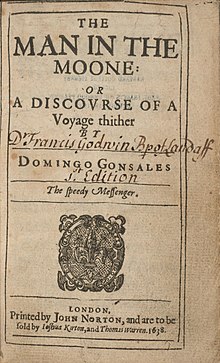The Man in the Moone

Title page of the first edition
|
|
| Author | Francis Godwin |
|---|---|
| Original title | The Man in the Moone or the Discovrse of a Voyage thither by Domingo Gonsales |
| Language | English |
| Genre | Science fiction |
| Published | 1638 (John Norton, London) |
The Man in the Moone is a book by the English divine and Church of England bishop Francis Godwin (1562–1633), describing a "voyage of utopian discovery". Long considered to be one of his early works, it is now generally thought to have been written in the late 1620s. It was first published posthumously in 1638 under the pseudonym of Domingo Gonsales. The work is notable for its role in what was called the "new astronomy", the branch of astronomy influenced especially by Nicolaus Copernicus. Although Copernicus is the only astronomer mentioned by name, the book also draws on the theories of Johannes Kepler and William Gilbert. Godwin's astronomical theories were greatly influenced by Galileo Galilei's Sidereus Nuncius (1610), but unlike Galileo, Godwin proposes that the dark spots on the Moon are seas, one of many parallels with Kepler's Somnium sive opus posthumum de astronomia lunari of 1634.
Gonsales is a Spaniard forced to flee the country after killing a man in a duel. Having made his fortune in the East Indies, he decides to return to Spain, but falls ill on the voyage home and is set off on the island of St Helena to recover. There he discovers a species of wild swan able to carry substantial loads, the gansa, and contrives a device that allows him to harness many of them together and fly around the island. Once fully recovered, Gonsales resumes his journey home, but his ship is attacked by an English fleet off the coast of Tenerife. He uses his flying machine to escape to the shore, but once safely landed he is approached by hostile natives and is forced to take off again. This time his birds fly higher and higher, towards the Moon, which they reach after a journey of twelve days. There Gonsales encounters the Lunars, a tall Christian people inhabiting what appears to be a utopian paradise. After six months of living among them, Gonsales becomes homesick and concerned for the condition of his birds, and sets off to return to Earth. He lands in China, where he is immediately arrested as a magician, but after learning the language manages to win the trust of the local mandarin. The story ends with Gonsales meeting a group of Jesuit missionaries, who arrange to have a written account of his adventures sent back to Spain.
...
Wikipedia
